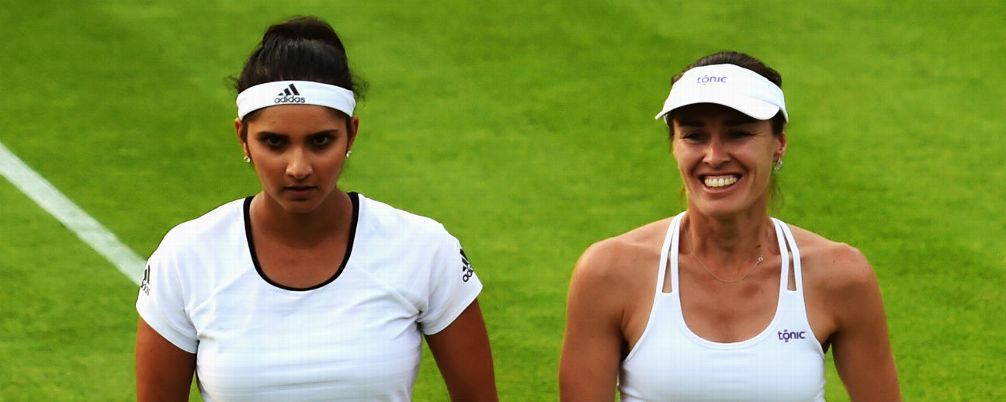
Call it the Third Coming of Martina Hingis at the All England Club. Or perhaps that should be the Fourth?
Nostalgia, as well as re-imagining and re-inventing the past, are central to this faux Victorian idyll in south-west London, and this prize-giving weekend will see Hingis play in a Wimbledon final for the first time since the 1990s.
Even better, she will play in a couple; there will be two nostalgia trips for the fan club of this former ladies' singles champion and women's doubles winner. So successful on this grass as a teenager, can Hingis - who is now 34 years old and, in her own analysis, "no longer a spring chicken" - earn a chair at the Champions' Dinner once again?
The first of her two chances to make it to the party comes on Saturday when she will partner India's Sania Mirza in the women's doubles final against the all-Russian pairing of Ekaterina Makarova and Elena Vesnina.
And then on Sunday she will play for the mixed doubles title alongside another Indian partner, Leander Paes, when they will face Austria's Alexander Peya and Hungary's Timea Babos. "Winning another Wimbledon title would be awesome," said Hingis.
So Hingis is only a year older than Serena Williams, but her history with the All England Club is considerably longer than the American's (though it has to be remembered that the Williams sisters didn't play any junior events).
More than anywhere else, this is the place that has defined her tennis life, with so many of the key moments in the Hingis narrative backdropped by green and purple.
First at Wimbledon, there was Hingis the junior. Can it really be 21 years - that's an entire lifetime for women's singles finalist Garbine Muguruza - since Hingis first played for a Wimbledon title? Yes, as an extraordinarily-gifted 13-year-old, she won the girls' singles prize in 1994.
That was the first phase of Hingis' tennis life. The second phase was what you might call her 'Swiss Miss' years when she moved up to the senior tournaments and almost immediately had an impact.
It was in 1996, when she was still only 15 years old, when she scored her first senior Wimbledon title; playing alongside Helena Sukova, she became the youngest women's doubles champion in the tournament's history.
But it was what she achieved as a teenage singles player that marked her out as a true grass-court great.
Her first appearance in the women's singles tournament had come in 1995, at the age of 14, when she had had the misfortune to be paired in the first round with Steffi Graf (she lost). The following summer, she ran into Graf again, this time in the fourth round, and again was beaten.
But in the summer of 1997, when Hingis was 16, she went through the draw sheet, with her victory over Jana Novotna in the final making her the youngest singles champion since the nineteenth century (since a 15-year-old Lottie Dod in 1887).
She would never win another singles title, but the following summer, aged 17 at the 1998 Championships, she would lift the doubles trophy again, on that occasion in collaboration with Novotna.
When she was a teenager in the 1990s was what you might call peak Hingis. She wouldn't win another Wimbledon title before retiring for the first time; in fact, she wouldn't reach another final.
Coming out of retirement, after deciding she still had more to give, Hingis didn't have anything like the same success on the Wimbledon grass as she had done either as a junior or as the Swiss Miss.
After losing in the third round of the 2007 singles tournament she gave a urine sample that was found to contain trace amounts of cocaine (she denied using the drug, but didn't appeal).
Banned for two years, Hingis appeared to have played her last tennis at the All England Club. But she came back again, returning to the top of the game as a doubles player.
As she told ESPN during this tournament, she doesn't feel as though she has the weaponry to still compete in the singles (her involvement in that event was restricted to mentoring her fellow Swiss Belinda Bencic, who made the fourth round). But as a doubles player, in both women's and mixed tournaments, she still has a lot of game.
"If I had a little of Serena Williams' physical abilities, I would probably still be playing singles"Martina Hingis
"If I had a little of Serena Williams' physical abilities, power and serve, I would probably still be out there myself, playing singles," she observed.
During her Swiss Miss days as a Wimbledon singles champion, she was never the biggest hitter of a tennis ball, and won matches with her clever-clogs use of touch, angles and changes of pace.
Be in no doubt that she has lost a little pace in her shots since then. But that craft and intelligence is even more useful on a doubles court than it was when playing singles.
"It's not about hitting the ball hard, but about finesse and strategy, and more about placement," she has reflected. The game of doubles somehow feels "easier and more natural" to her.
Back in the 1990s, Hingis used to laugh and say that she was a better doubles player than singles player. Almost 20 years on, she is reflecting that maybe that wasn't a joke after all.
No comments:
Post a Comment